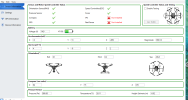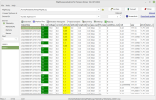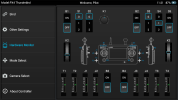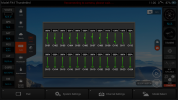Hey guys, lots of hours and good people along the way of fixing papa's drone.
Issues known when I got the rig from Mom:
1. Both batteries he had for it (Yuneec Originals) were swollen to a level that made insertion and removal from the drone complicated to say the least. Nothing was broken but they weren't happy in there and beyond first initial testing (10 mins or so) weren't used again.
2. CGO3+ is completely unresponsive. No power, no lights, just dead. It was more or less intact but bent up kinda, and just not sitting right. Noticed it looked like it had been worked on already, screws over tight and flexing plastic, covers not fit properly.
3. No GPS on a day with clear sky's, mostly full view of the sky...well ok, there's a tree...but should get something at least, right? ST 16 had connection to the drone, I could arm the motors (Props removed) in Angle mode, they would all spin seemingly how I would imagine they should, no 5 motor type errors. Had voltage of the Typhoon on the ST16, no GPS/SAT/POS/ALT/G-SPD...can't remember if it had distance.
So that's what I observed. So I got to doing research, ordered two batteries and a replacement GPS board. Come to find out the one in the drone was pretty badly damaged when I inspected it.
Swapped it and was going to say repair complete in all areas, and came across my G-SPD fluctuating while grounded. Here's a link to the video.
Right now I'm chalking it up to being in my backyard, with a tree somewhat overhead. I wondered if you guys could give me your opinion and any other ways I can test this puppy before I put on the props and take off the leash? I'm anxious to fly it, but this isn't the area for it and it's a little intimidating.
Also, what Mode type do you guys use? Mine was set at Mode 2, but I'm not sure if that's the default or because dad was a southpaw. Any flight training videos I've seen don't really address this. I mean specifically the ST16 settings for ELE/RUD THR/AIL...I may have some of those letters mixed up.
I've included some crash gore of the condition when I got it and some observations of removed parts, for your enjoyment. I don't have a dog or cat, otherwise I'd post one of those
Thanks for reading, can't wait to hear from y'all!
-JJ
Issues known when I got the rig from Mom:
1. Both batteries he had for it (Yuneec Originals) were swollen to a level that made insertion and removal from the drone complicated to say the least. Nothing was broken but they weren't happy in there and beyond first initial testing (10 mins or so) weren't used again.
2. CGO3+ is completely unresponsive. No power, no lights, just dead. It was more or less intact but bent up kinda, and just not sitting right. Noticed it looked like it had been worked on already, screws over tight and flexing plastic, covers not fit properly.
3. No GPS on a day with clear sky's, mostly full view of the sky...well ok, there's a tree...but should get something at least, right? ST 16 had connection to the drone, I could arm the motors (Props removed) in Angle mode, they would all spin seemingly how I would imagine they should, no 5 motor type errors. Had voltage of the Typhoon on the ST16, no GPS/SAT/POS/ALT/G-SPD...can't remember if it had distance.
So that's what I observed. So I got to doing research, ordered two batteries and a replacement GPS board. Come to find out the one in the drone was pretty badly damaged when I inspected it.
Swapped it and was going to say repair complete in all areas, and came across my G-SPD fluctuating while grounded. Here's a link to the video.
Right now I'm chalking it up to being in my backyard, with a tree somewhat overhead. I wondered if you guys could give me your opinion and any other ways I can test this puppy before I put on the props and take off the leash? I'm anxious to fly it, but this isn't the area for it and it's a little intimidating.
Also, what Mode type do you guys use? Mine was set at Mode 2, but I'm not sure if that's the default or because dad was a southpaw. Any flight training videos I've seen don't really address this. I mean specifically the ST16 settings for ELE/RUD THR/AIL...I may have some of those letters mixed up.
I've included some crash gore of the condition when I got it and some observations of removed parts, for your enjoyment. I don't have a dog or cat, otherwise I'd post one of those
Thanks for reading, can't wait to hear from y'all!
-JJ
Attachments
-
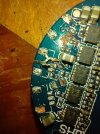 IMG_20220707_231615529_HDR.jpg390 KB · Views: 16
IMG_20220707_231615529_HDR.jpg390 KB · Views: 16 -
 16599066617821201967864974632448.jpg3 MB · Views: 14
16599066617821201967864974632448.jpg3 MB · Views: 14 -
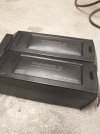 16599066148287139192557552802317.jpg1.4 MB · Views: 13
16599066148287139192557552802317.jpg1.4 MB · Views: 13 -
 16599063263104358445515207497267.jpg5 MB · Views: 15
16599063263104358445515207497267.jpg5 MB · Views: 15 -
 1659906199584826032994379868814.jpg4.8 MB · Views: 15
1659906199584826032994379868814.jpg4.8 MB · Views: 15 -
 IMG_20220807_152318422.jpg5.7 MB · Views: 15
IMG_20220807_152318422.jpg5.7 MB · Views: 15 -
 IMG_20220704_023344447_HDR.jpg2.8 MB · Views: 15
IMG_20220704_023344447_HDR.jpg2.8 MB · Views: 15




